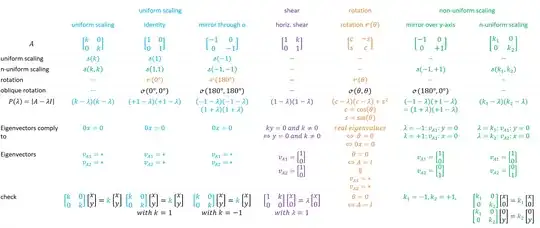I am really confused with this question: Find the eigenvalues and eigenvectors of A geometrically: $$ A = \begin {pmatrix} 0 & 1 \\ 1 & 0 \end {pmatrix} $$^ reflection in the line $y=x$.
Thanks.
I am really confused with this question: Find the eigenvalues and eigenvectors of A geometrically: $$ A = \begin {pmatrix} 0 & 1 \\ 1 & 0 \end {pmatrix} $$^ reflection in the line $y=x$.
Thanks.
I am trying to understand the question. Forgive me if I am totally off. But reflection in $y=x$ means geometrically that any vector on the line, stays where it is, which corresponds with an eigenvalue of 1. Any perpendicular vector to the line, is mapped exactly to its "other" side, which corresponds with an eigenvalue of -1. (The entries of the vector are switched signs)
It helps to recall what eigenvalues and eigenvectors actually mean. Let's start with eigenvectors of a matrix. As I'm sure you're aware, a matrix $A$ can be viewed, instead, as a linear transformation which we'll call $T_A$. An eigenvector of $A$ is often given by the definition that it is a vector $x$ such that $Ax=\lambda x$ for some real number $\lambda$. This in itself isn't very illuminating until we unwrap what the equation in the definition is telling us.
It's really saying that the linear transformation $T_A(x)$, which is equal to $Ax$, doesn't actually change the line through the origin on which the vector $x$ is sitting. It might be pushed along the line, further away from the origin, or it might be pulled towards the origin, but it will stay on that line. So an eigenvector of a matrix is really just a fancy way of saying 'a vector which gets pushed along a line'.
So, under this interpretation what is the eigenvalue associated with an eigenvector. Well in the definition for an eigenvector given about, the associated eigenvalue is the real number $\lambda$, and after unwrapping what does this mean? Well $T_A(x)=\lambda x$, so we already know $x$ stays on the line because its an eigenvector, and from the above equation, we actually know that $x$ has moved to $\lambda x$ - but that means $\lambda$ is just telling us the scaling factor which is being applied to the line that the vector $x$ spans. So if $\lambda>1$, then the line gets expanded by a factor of $\lambda$, if $\lambda=1$ then the line gets fixed pointwise, if $0<\lambda<1$ then the line gets shrunk by a factor of $1/\lambda$, and if $\lambda=0$ then everything on the line gets mapped to $0$. If $\lambda$ is negative, then it does the same as above, but it also reflects everything about the origin, so the line gets flipped and then shrunk or expanded.
Given all of this, you should be able to quite easily see which lines get fixed by your matrix, and also how much they are affected by the transformation.
For the question this thread started from:
I created an (animated!) geogebra plot showing this reflection: https://www.geogebra.org/m/ny2mqgnm
More detail on geometric interpretation of eigenv(alues/ectors):
I elaborated 'a truly geometric derivation' of eigenvalues and eigenvectors for 2x2 matrices in relationship between a matrix with specific eigenvectors and eigenvalues
For that purpose, I use the concept of an eigencircle
I created the following overview showing the eigenvalues and eigenvectors of elementary transformations corresponding to 2x2-matrices.
The effect of these 'basic' transformations are easy to imagine, so once you can interpret the effect of these matrices, you will also understand the associated eigenvectors/eigenvalues.
$\mathcal{t}$ is 'a' linear transformation,
$\mathcal{s}$ is a scaling,
$\mathcal{r}$ is a rotation.
$\mathcal{o}$ is an oblique rotation: an oblique rotation rotates the basisvectors over different angles.
A 'normal' rotation $\mathcal{r}$ is an orthogonal rotation: all vectors are rotated over the same angle.
If you want me to add more info, just post a comment.
You can also visit Heavisides Dinner.
